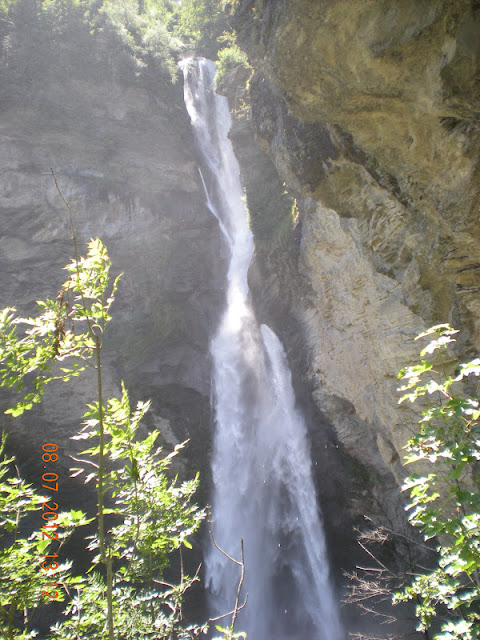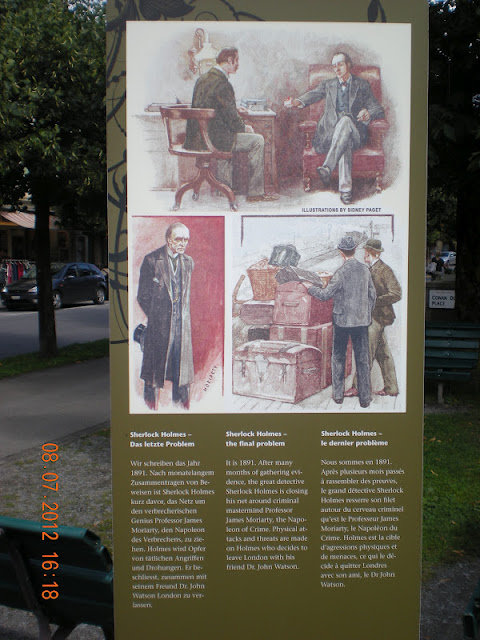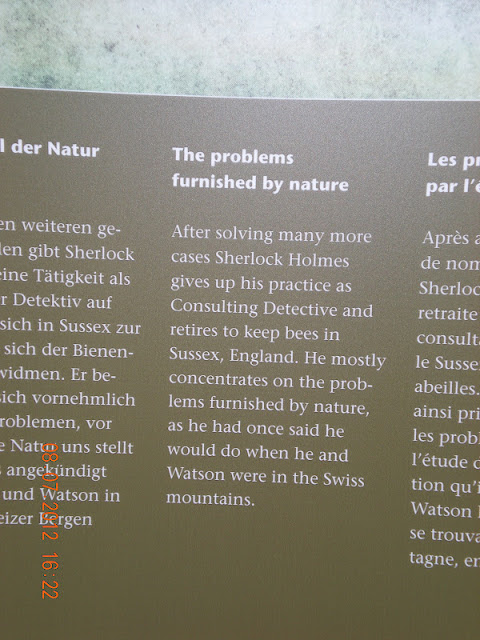Paula had to lead a sales workshop on August 7th & 8th, which required
her to work late on those days.
So, I decided to visit a place that I have always wanted to see, Reichenbach
Falls, in Meiringen, (My ring gun) Switzerland. Those of you who are Sherlock Holmes fans know that these
are the falls that, Arthur Conan Doyle, the creator of the great fictional detective,
had Holmes’ presumed “death” struggle, with his archenemy, Professor Moriarty. He is one of my favorite authors, in
addition to writing all of the Sherlock Holmes stores, he also wrote The Lost World.
Meiringen is about a 3-hour
train ride northeast of Vevey, in the Bernese Oberland area of Switzerland
Arthur Conan Doyle
was born on May 22,1859 in Edinburgh, Scotland.
Conan Doyle was
educated in Jesuit schools and later studied at Edinburgh University,
qualifying as a doctor in 1885. After graduation he practiced medicine until
1891, when he became a full time writer.
In developing his
own literary character, Conan Doyle based Sherlock Holmes on Doctor Joseph
Bell, a surgeon and teacher he had studied with while attending Edinburgh
University. Dr. Bell had the uncanny ability to reveal a patients symptoms,
diagnose patients and report on their origins before they would speak a word to
him about their afflictions. Sir Henry Littlejohn, who taught forensic medicine
to Conan Doyle also made a large impression and contributed to the development
of Holmes' character.
As far as Holmes'
name, his last name may have been based on American jurist and fellow doctor
Oliver Wendell Holmes and his first name may have come from Alfred Sherlock, a
prominent violinist of his time. Dr. John Watson, a fellow doctor, received the
honor of having Holmes' partner named for him.
Conan Doyle worked
backwards from the solution of a case to create his stories. A Study in
Scarlet was his first story and novel and introduced the characters of
Holmes and Watson and included how they met. Watson, on leave due to injury
sustained during the second Afghan War, returns to London without friends or
relatives in town. He exhausts his savings and is made aware of someone looking
to share lodgings. The gentleman, Sherlock Holmes, identifies himself as a
consulting detective often contacted by Scotland Yard inspectors Lestrade and
Gregson to assist in cases.
A Study in Scarlet was written in three weeks in 1886 and published
in 1887. The second Sherlock Holmes story, The Sign of the Four, was
written for the Lippincott's Magazine and the later stories appeared in
the Strand Magazine.
Conan Doyle soon came to hate this character he had created, he felt the Sherlock Holmes stories were
distracting him from more serious literary efforts and that "killing" Holmes off was the
only way of getting his career back on track. "I must save my mind for
better things," he wrote to his mother at the time, "even if it means
I must bury my pocketbook with him”.
So
on May 4, 1891, he kills off Sherlock in The Final Problem. He
meant to stop writing about his famous detective after this short story. He sought to sweeten the pill by
letting Holmes go in a blaze of glory, having rid the world of a criminal so
powerful and dangerous as Professor James Moriarty,
that any further task would be
trivial in comparison. In the story, Holmes meets Professor Moriarty at
Reichenbach Falls, in Switzerland, and disappears. But this device failed in its purpose and
pressure from fans eventually persuaded Conan Doyle, in 1901, to bring Holmes
back, writing The Hound of the Baskervilles
and reviving him in The Adventure of the
Empty House. There were enough
holes in eyewitness accounts to allow Conan Doyle to plausibly resurrect
Holmes; only the few free surviving members of Moriarty's organization and
Holmes' brother Mycroft (who appears briefly in the story) know that Sherlock
Holmes is still alive, having won the struggle at Reichenbach Falls and sent
Moriarty to his death
He kept
writing Sherlock Holmes stories until 1927, three years before he died. He wrote a total of 56 short stores and
four novels featuring the great detective.
On October 24,1902 King
Edward VII knighted Conan Doyle for his services, as a doctor, during the South
African War, also known as the Second Boer War (1899 – 1902). There were
reports (mainly spread by Kaiser Wilhelm II of Germany) that the British were
torturing and abusing the white Dutch South Africans (the Boers) during that
war. Arthur Conan Doyle wrote a pamphlet saying - I'm being simple and brief -
"I was there and saw no atrocities by the British against the Boer
civilians."
Conan Doyle died on
July 7th,1930 from heart disease at his home in Sussex, England. Conan Doyle's other publications include non-fiction, plays,
verse, memoirs, short stories, and several historical novels and supernatural
and speculative fiction. The Lost World is perhaps the best known of his
other fictional works.
Arriving at the Meiringen Train Station.
After I checked into my hotel I headed for Reichenbach Falls. Because my left foot is still not 100%, I rode the funicular which takes you to a station about half way up the falls. I walked the rest of the way to the very top of the falls. The water fall drops over 400 feet.
The upper Reichenbach Falls.
It is hard to see, but there is a white cross on the left hand side of this picture, about three-quarters of the way up, where the dark and light colors meet. This is the exact spot where, according to the Sherlock Holmes Society of London, the final tussle between Holmes and Moriarty is meant to have taken place. Every year on May 4th, the anniversary of the famous but fictitious event, Society members come to Meiringen dressed in deerstalker hats and tweed capes, and re-enact it, although this presumably does not include one of them jumping into the waterfall.
A better picture of the white cross. It is a cross even though in this picture it appears as a star.
The city of Meiringen from Reichenbach Falls. Meiringen sits in the Hasli Valley. The valley was craved out by glaciers many millions of years ago.
In downtown Meiringen, there is a square dedicated to Sherlock Holmes. In the square, are these paintings that depict "The Final Problem".
Sherlock Holmes Honorary Citizen of Meiringen.
This Bronze Sculpture, by John Doubleday
1988, represents Sherlock Holmes in a pensive mood, some hours before his final
and fateful encounter at the Reichenbach Falls on May 4, 1891 with “the
Napoleon of crime” Professor James Moriarty.
Hidden on the statue, or associated with
it, are clues – mainly in the form of symbols – to each of the sixty Sherlock
Holmes stories. All are visible, though some are fittingly obscure. From these,
depending only upon powers of observations, it is possible to compile a
complete list of all the sixty stories. It is a challenge and “is certainly a
most curious little problem”. (This is one of Sherlock's trademark quotes).
The statue of Sherlock in front of the Meiringen English Church, which now houses the Sherlock Holmes Museum.
The church is considered to be one of the most beautiful churches in Switzerland.
A picture of one of the streets in Meiringen, which is in the Canton of Bern. The Coat of Arms for the Canton of Bern is the "bear". Bern in old German means bear. The Canton of Bern is the second largest of the 26 Swiss Cantons in both surface area and population.
The next day I traveled to Lauterbrunnen to see Trummelbach Falls and to take the lift to Schithorn, the location of the Piz Gloria, the revolving restaurant made famous in the James Bond movie On Her Majesty's Secret Service (1969).
Lauterbrunnen is situated in one of
the most impressive trough valleys in the Alps, between gigantic rock faces and
mountain peaks. With its 72 thundering waterfalls, secluded valleys, colorful
alpine meadows and lonely mountain inns, the Lauterbrunnen Valley is one of the
biggest nature conservation areas in Switzerland.
The Trummelbach Falls (In German: Trümmelbachfälle) are a series of ten glacier-waterfalls inside a mountain made accessible by
tunnel-lift and illuminated tunnel paths.
The Trummelbach drains the mighty glaciers of the Eiger (13,026 ft), the Monch (13,475 ft) and the Jungfrau (13,642 ft) and carries 20,200 tons of boulder debris per year.
Its drainage area is over 10 square miles, half of it
covered by snow and glaciers. The falls carry up to 5,283 gallons of water per
second. These are the only glacier-waterfalls, in Europe, that is inside a mountain and still accessible.
I am only showing a few of the falls, not all 10. However, they are all very impressive. The noise inside the mountain is incredible. It seems noisier than standing next to a jet engine.
The most famous falls are named The Corkscrew. This picture does not convey all of the twists and turns it makes on its way down the inside of the mountain.
I left the falls and headed for Stechelberg to catch the cable car to Schilthorn. It takes five cable car changes to reach the top. The car starts in Stechelberg (2,844 ft). The next station is Gimmelwalt (4,485 ft). Then Murren (5,374 ft). Then Birg (8,783 ft). The last car then arrives at Schilthorn (9,744 ft). This picture was taken as the car left Birg, headed for Schilthorn.
Arriving at Schilthorn.
The Piz Gloria restaurant.
Given the difficult topographic and climatic
conditions, construction units were prefabricated. The outer skin of the glass
circular upper floor is of aluminum-skinned wooden panels,
that originally was an aluminum-coated tent roof. The rotative mechanism — a 40 foot diameter core with a 10 foot ring that completely rotates the upper floor in approximately an hour — allows every
guest to have a view. In 1990, the restaurant was enlarged to accommodate some
400 diners, while retaining its original architectural character.
The name Piz Gloria originated in Ian Fleming's James Bond novel On Her Majesty's Secret Service (1963), wherein the hideout of the villain, Ernst Stavro Blofeld,
is Piz Gloria, a mountain-top building containing an allergies
investigation clinic. In the movie the location is implied as being near St
Moritz where Romansh is still spoken, and "Piz" would be appropriate as the dialect name
for peak. However the restaurant is actually located in the Bernese Oberland area,
where Romansh is not spoken and "piz" is not used.
The movie production team found the restaurant
partly constructed, and financially contributed to its completion in return for
exclusive use for filming the movie (released in 1969), where the building is shown quite prominently.
In the film, Bond's cover at the clinic is
blown after he is caught seducing women, but he manages to escape the complex
by skiing down the mountain sides despite the attempts of Blofeld and his men
to kill him.
Afterwards, the restaurant retained the Piz
Gloria name of the film location, and currently acknowledges the film's
significant contribution to its commercial reputation; on the lower floor it features a James Bond
exhibition, containing memorabilia and film clips.
The world's highest revolving restaurant is now
the Metro-Alpin restaurant at (11,483 ft.) at the top of the Saas-Fee lift system, which is about 90 miles southeast of Vevey. The Piz
Gloria is (9,744 ft.) and third revolving
restaurant, the Kuklos, (6,719 ft.) which is located above Leysin, about 26 miles southeast of Vevey.
The Jungfrau.
Picture taken from Schilthorn.
The cable car as it returns to Stechelberg.
As I was departing my cable car, I heard the sound of Alpen horns. There were 3 Swiss gentleman playing the horns and the sound that was reverberating off of the canyon walls was incredible. Unfortunately, they stopped playing before I could get a picture.











































No comments:
Post a Comment